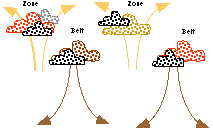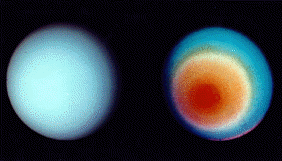This is an image of a volcanic cloud which goes from the troposphere to the stratosphere.
Click on image for full size
Image from: National Geographic magazine
An Overview of Uranus' Atmospheric Structure
As on Earth, the atmosphere of Uranus consists of a troposphere, stratosphere, mesosphere, and thermosphere. The
troposphere is the region where the visible clouds are to be found. The
stratosphere, as on Earth, is a region where the atmosphere warms. Unlike the Earth however, where stratospheric warming is caused by the presence of ozone, the causes of the warming of the Uranian stratosphere are the hazes of methane to be found there. The
mesosphere of Uranus, as on other planets, is a static region, a region of balance between incoming and outgoing energy. The
thermosphere is the other region of the atmosphere where the atmosphere warms. The
ionosphere is the region of the atmosphere that is filled with charged particles. For a picture showing how the temperature changes in whole atmosphere, click
here.
You might also be interested in:

The mesosphere of Uranus is a region of balance between warming and cooling. That essentially means that nothing happens there. Except for diffusion, the atmosphere is still. Upper reaches of the atmosphere,
...more
Besides methane, Uranus' atmosphere contains more sophisticated atmospheric molecules such as ethane gas, acetylene, and diacetylene. All these molecules form layers of haze at different altitudes high
...more
As on Earth, the atmosphere of Uranus consists of a troposphere, stratosphere, mesosphere, and thermosphere. The troposphere is the region where the visible clouds are to be found. The stratosphere, as
...more
On Uranus, as on Jupiter, the winds in the belts and zones blow first in one direction, then in the opposite direction. Wind blows east in a belt, and west in a zone. The clouds rise up in a belt, and
...more
The striped cloud bands on Uranus, like Jupiter, are divided into belts and zones. On Uranus the belts and zones are hard to distinquish. The left picture shows the north pole of Uranus. In this picture
...more
The clouds of Uranus, composed of methane crystals, are found very low in the troposphere, and are difficult to distinquish below the smog haz es of the planet's atmosphere. False color is used, in the
...more
In this picture, the view of the north poles of the Earth and Uranus are shown together. In the view of the Earth, the sun is shining from the left, and part of the north pole is in daylight and part of
...more









